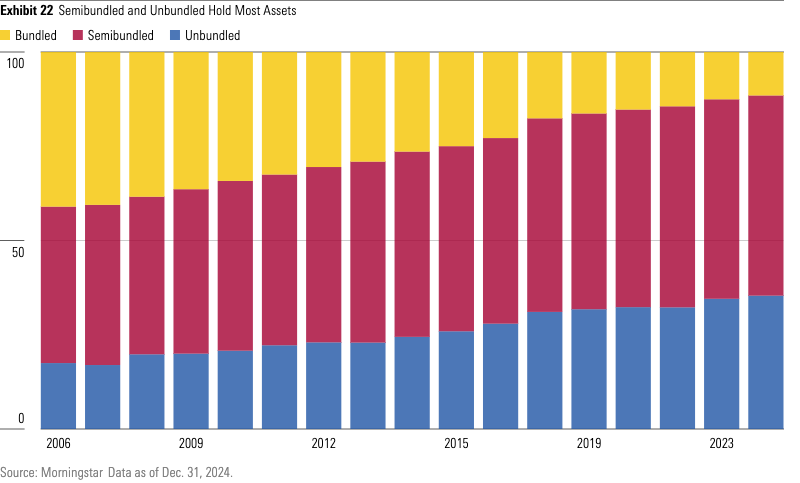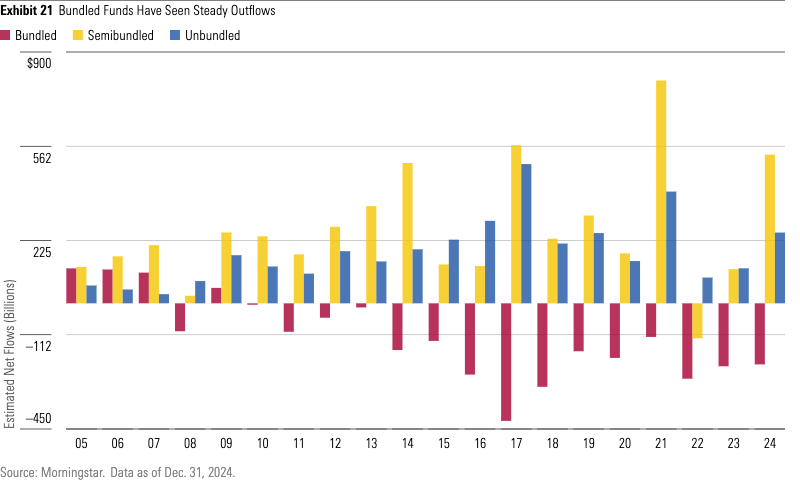5 min read
Fund Fees Are Still Declining, But Not as Quickly as They Once Were
A deep dive into the factors driving fee trends across asset managers.

Key Takeaways
Investors saved an estimated $5.9 billion in fund expenses last year as the asset-weighted average expense ratio for all US mutual funds and exchange-traded funds ticked down to 0.34% in 2024 from 0.36% in 2023.
The economics of the advice business is shaping flows and fees. Fee-based advisors prefer unbundled funds as they make room for the price of advice. Unbundled funds have seen net inflows for the past 20 years.
The fee gap between new mutual funds and new ETFs has narrowed. Newly launched ETFs are still less expensive than new mutual funds, however.
The Basics of Fund Fees ft. Zach Evens
In 2024, the average expense ratio paid by fund investors was less than half what it was two decades ago. Between 2005 and 2024, the asset-weighted average fee fell to 0.34% from 0.83%. As a result, investors have saved billions in fund fees.
Three factors played a role in lowering fees:
- Investors are increasingly aware of the importance of minimizing investment costs, which has led them to heavily favor lower-cost funds.
- Competition among asset managers has led many to cut fees.
- The move toward fee-based models of charging for financial advice has been a key driver of the shift toward lower-cost funds, share classes, and fund types—most notably exchange-traded funds.
Fund fees are not falling as fast as they used to, however. Two factors are behind this slowing rate of change:
- Fees of prominent index mutual funds and ETFs are approaching a floor, with many already charging less than 0.05%.
- The emergence of active and alternative ETFs contributes to higher-priced ETF launches than previously observed.
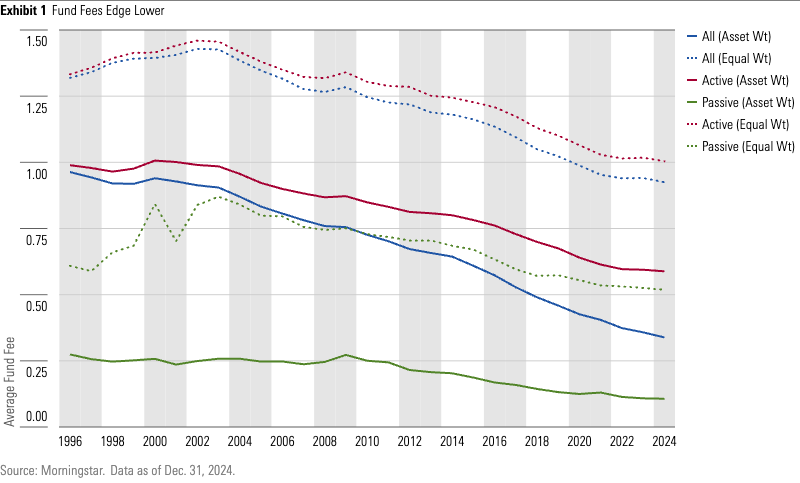
The Fee Squeeze Shows Signs of Slowing
We examined the trend in fund expenses using the asset-weighted average expense ratio. The asset-weighted average better represents the average costs borne by fund investors than an equal-weighted average because it approximates what investors paid rather than what funds charged.
The asset-weighted average expense ratio for active US equity funds was 0.60% in 2024. The asset-weighted average expense ratio for all active funds was 0.59% in 2023 and 2024, and the asset-weighted average expense ratio for all passive funds was 0.11% in 2023 and 2024. Declines in asset-weighted average fees were more muted than in previous years, but the average investor still paid less in 2024 than in 2023.
Lower asset-weighted fees are possible thanks to a combination of inflows into low-cost funds, outflows from more costly ones, fee cuts, and relative underperformance by more-expensive funds.
In aggregate, last year’s asset-weighted expense ratios for actively managed and passive funds declined just 1% and 1.5%, respectively, from 2023.
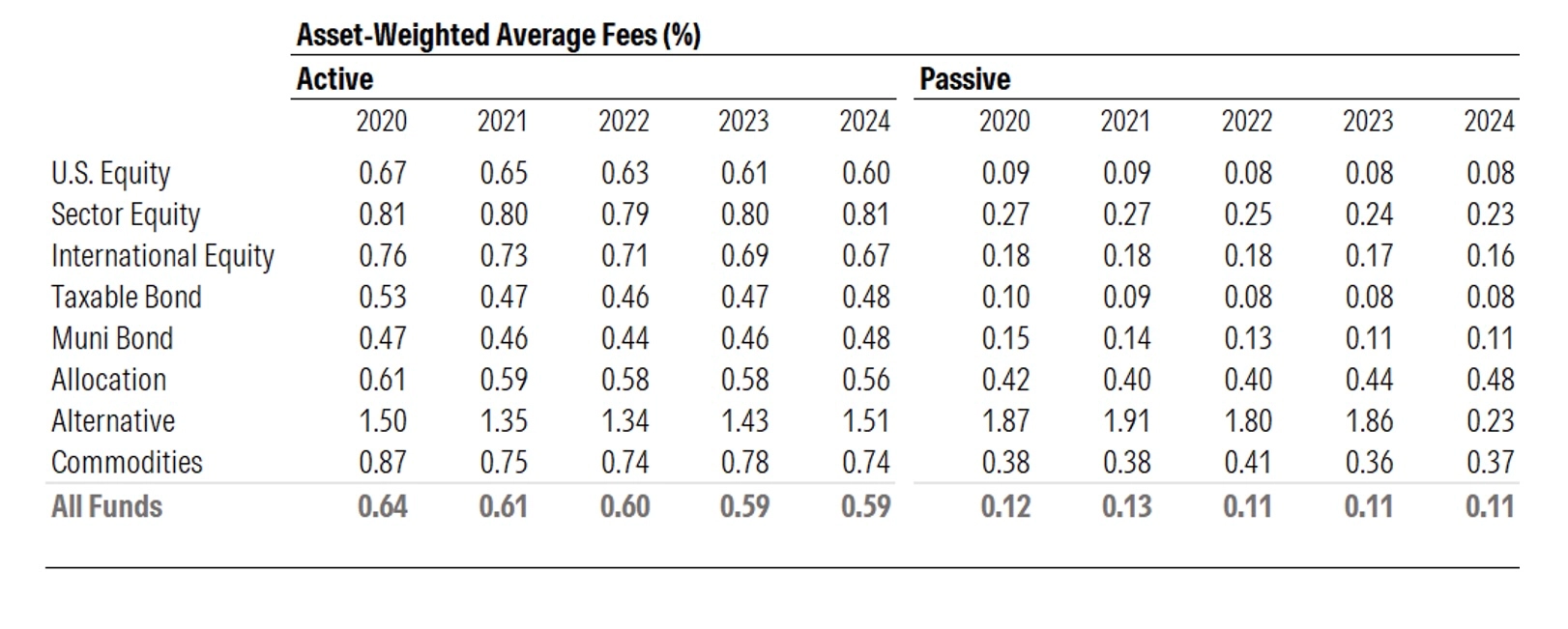
Source: Morningstar, Inc. Data as of 12/31/2024.
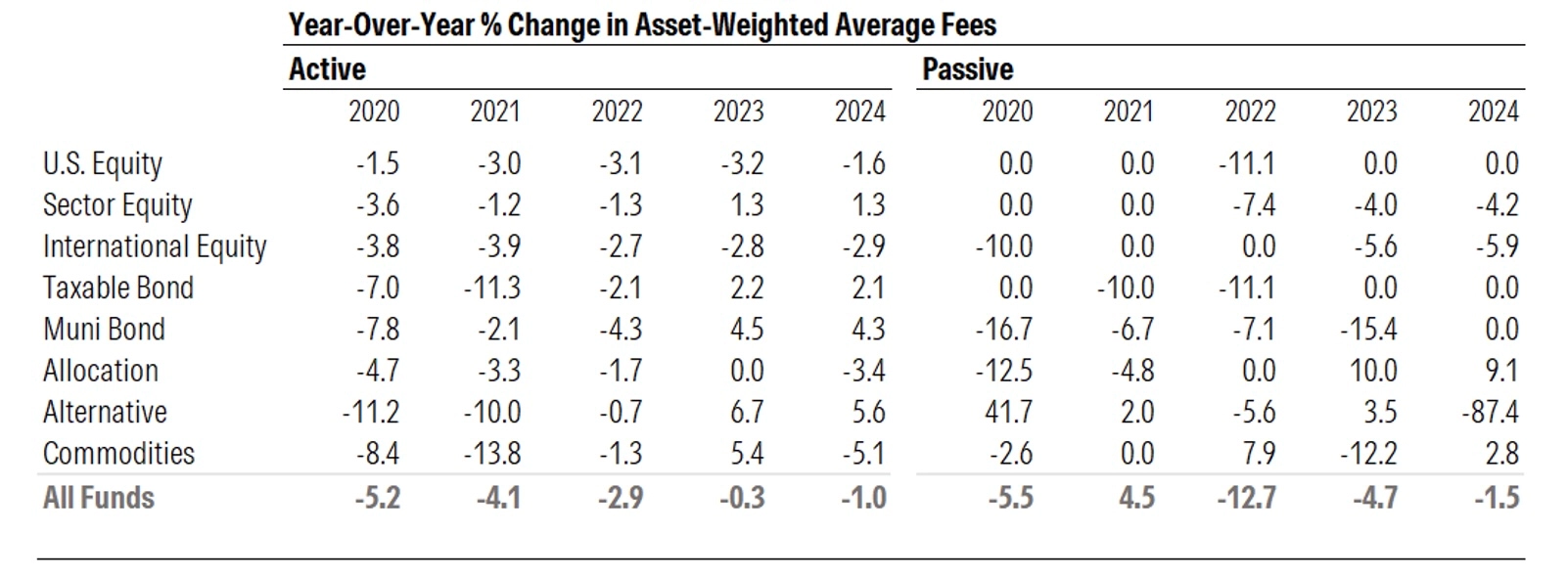
Source: Morningstar, Inc. Data as of 12/31/2024.
The “Fee War” May Be Winding Down
In recent years, index mutual funds and ETFs have experienced significant fee pressure. Most notably, providers of broad market index funds have been engaged in what has been dubbed a “fee war.” In September 2018, fee fighting reached what seemed at the time to be its inevitable conclusion when Fidelity launched its lineup of zero-fee index mutual funds. More recently, other asset managers have followed suit.
As fees for these funds sit either at or near zero, the pace of fee declines will inevitably slow, prompting asset managers to look elsewhere for profits.

Source: Morningstar, Inc. Data as of 12/31/24.
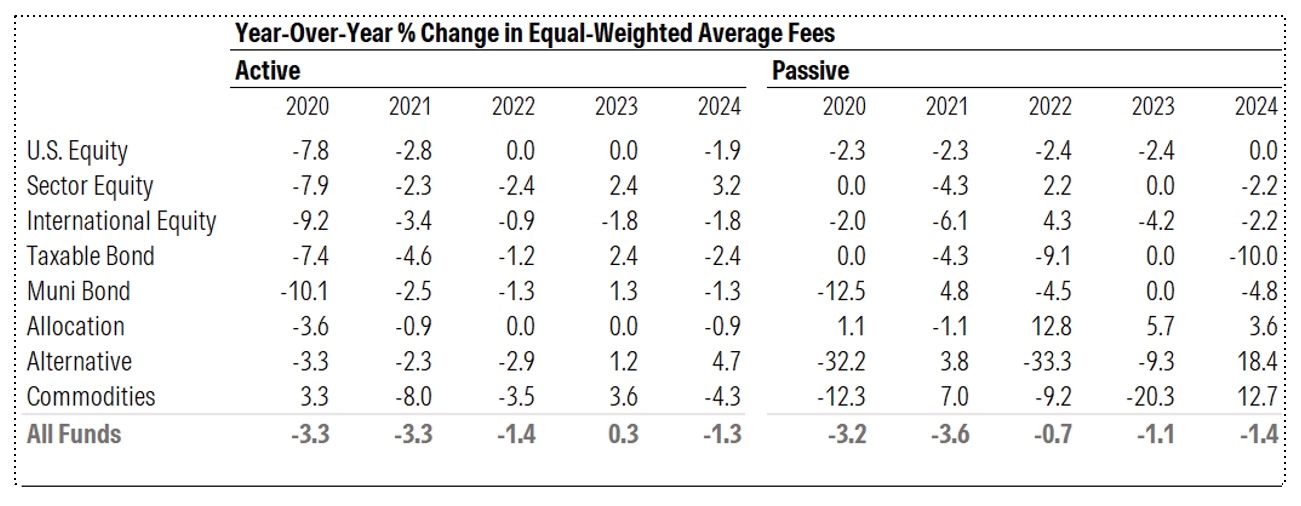
Source: Morningstar, Inc. Data as of 12/31/24.
Mutual Fund Fees Are on Their Way to Matching ETF Fees

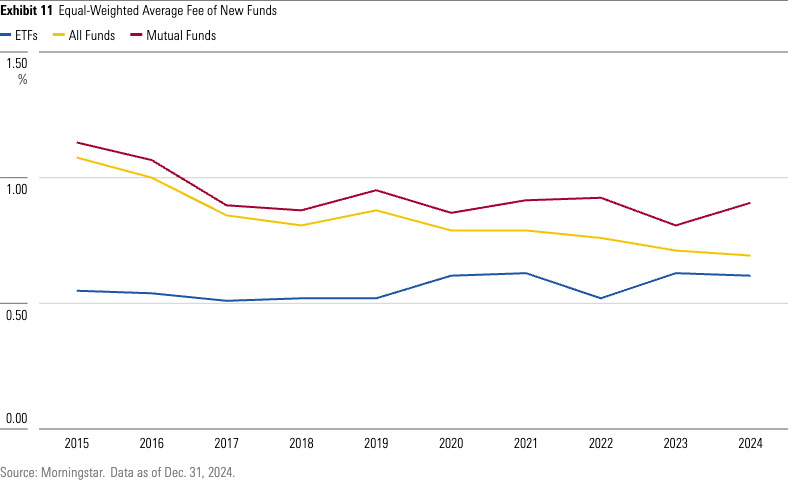
How Fund Fees Are Shaped by the Economics of Advice
Classifying Service-Fee Arrangements
The evolution of the economics of the advice business is shaping flows and, by extension, fees. As advisors move away from transaction-driven compensation models and toward fee-based ones, less costly funds and share classes, those that have fewer if any embedded advice or distribution costs, are seeing more flows.
The service-fee arrangement attribute in our US funds database classifies funds based on their service-fee arrangements between asset managers, distributors, advisors, and investors. It aims to help investors discern how they might be paying for advice—either directly to an advisor in the form of a fee or indirectly via the fees they pay for the funds they invest in.
In practice, investors might be paying for advice via some combination of the two, but this classification of funds into unbundled, semibundled, and bundled buckets is a useful means of beginning to understand what investors are getting in return for the fund fees.
The definitions of these groups are as follows:
- Unbundled: An investor simply pays for investment management and fund operating expenses, and the fund and its advisor do not pay third parties who sell their funds to the public. Unbundled share classes reduce conflicts, but investors still need to ask whether they are paying a reasonable amount for advice and for the services that their intermediary charges them directly.
- Semibundled: The product charges no traditional distribution fees (or 12b-1 fees) or load-sharing but can have revenue-sharing or subtransfer agency fees. Semibundled share classes could create some potential conflicts of interest that investors need to ask about.
- Bundled: These are traditional share classes, where the investor pays a load and a 12b-1 fee to the mutual fund, which in turn pays the intermediary. Bundled share classes are purely transactional, which can work well for sophisticated investors who have done their homework and wish to pay upfront commissions. Advice associated with these share classes may ultimately cost less.
Flows Follow the Transition to Fee-Based Advice Models
Bundled share classes have been in steady outflows, while semibundled and unbundled share classes have seen mostly steady inflows.
This corresponds to the shift away from transaction-driven advice models, which favor load shares, and toward fee-based ones. The result is that investment product costs are being displaced by advisor fees.
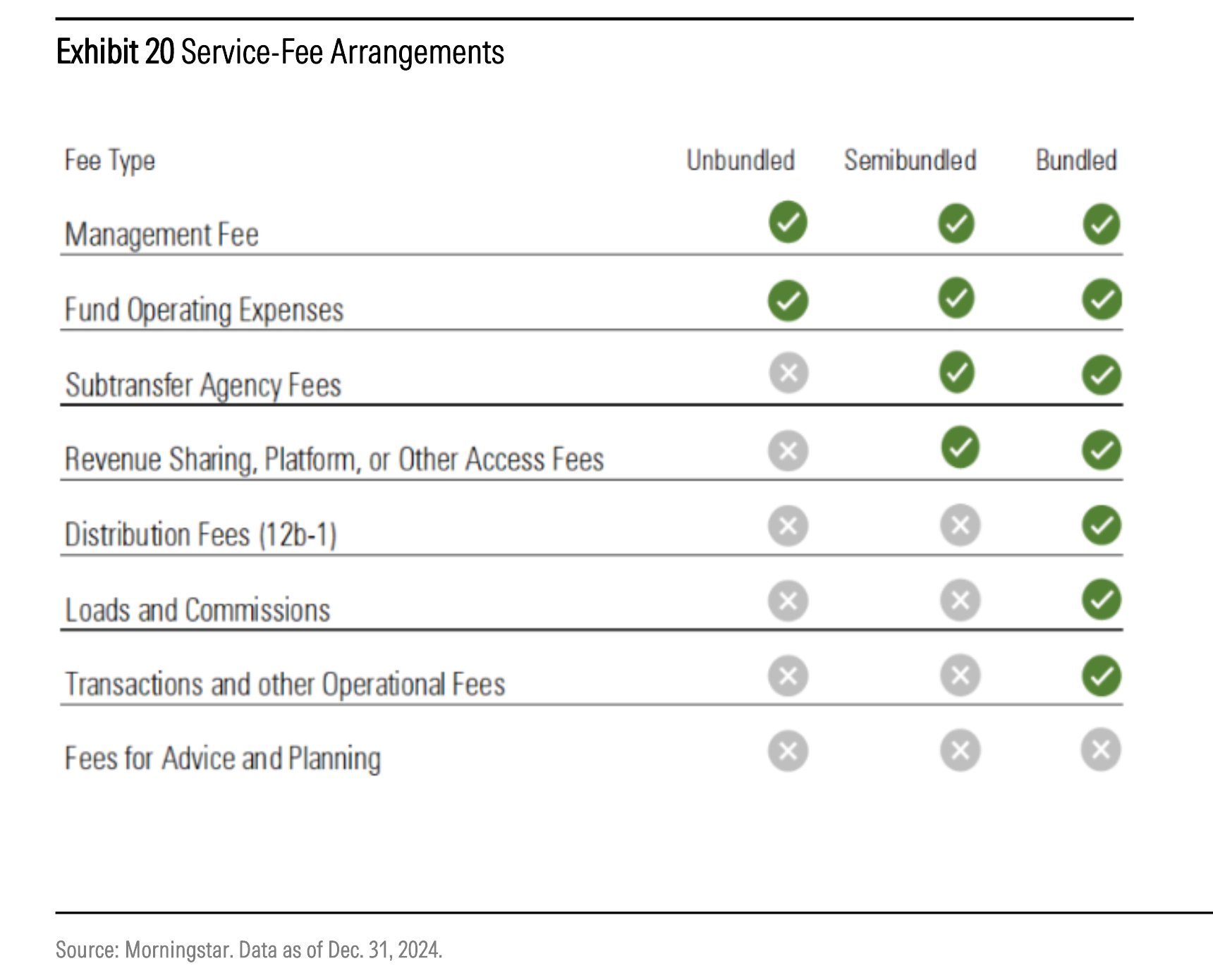
Fees Fell Across Service-Fee Arrangements, But Not Everywhere
